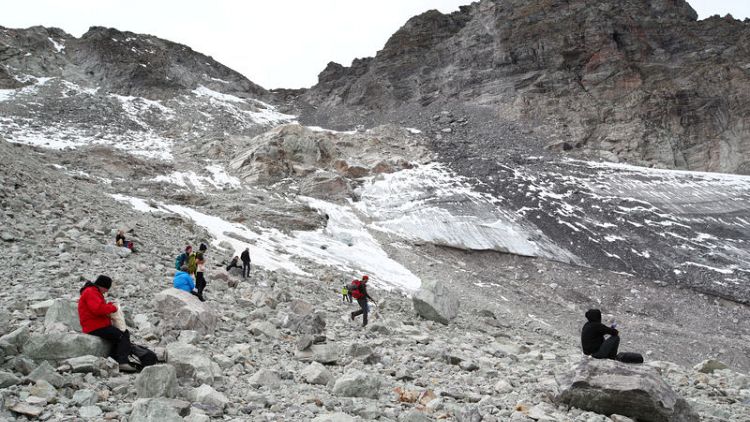By Emma Farge
GENEVA (Reuters) - Glaciers will melt faster than current models on climate change account for as algae blooms colonise them and reduce their ability to reflect the sun's heat, scientists studying glaciers said.
"Glacial darkening" is where deep purple, bulbous algae sprout on a layer of naturally occurring dust mixed with soot from air pollution and forest fires. Their presence has been confirmed for decades but as temperatures rise, more algae are thriving on the ice surface, staining glaciers the world over.
Scientists differ on how much additional melting this will cause but four scientists who are studying glaciers told Reuters it would exceed what was accounted for in current projections, including those in a landmark U.N. report released in September.
"Glaciers have algae growths often feeding on carbon deposits so that is further darkening the ice," said John Pomeroy, a professor at Canada's University of Saskatchewan, on the sidelines of a "High Mountain Summit" in Geneva this week.
"These are not currently considered in our models for glacier melt and almost certainly will accelerate it further than our estimates currently show."
Policy-makers and experts are convening at the U.N.'s World Meteorological Organization this week to discuss how to mitigate risks such as flash floods and droughts in mountain areas caused by global warming.
A study released last month by the U.N.-backed Intergovernmental Panel on Climate Change (IPCC) predicted that glaciers in polar and high mountain regions will likely lose "substantial mass" by the end of the century, ultimately raising sea levels.
The host of the meeting, Switzerland, has already lost 500 glaciers since the start of the last century and it could lose 90% of the remaining 4,000 if nothing is done to reduce greenhouse gas emissions by 2100, Home Affairs Minister Alain Berset told participants.
That is without accounting for glacial darkening.
"If you darken the ice then it melts faster. These are new insights," said Konrad Steffen, director of the Swiss Federal Institute for Forest, Snow and Landscape Research.
He said he expected this to increase melting by "up to 10%" versus current Swiss estimates, a percentage he said was conservative.
Preliminary results from an EU-backed "DEEP PURPLE" research project in Greenland showed much higher rates, the project's microbiologist Alexandre Anesio said.
In western Canada, wildfires linked to climate change are leaving ashy deposits on glaciers, creating habitats for algae and accelerating the warming process in a feedback loop.
"What our data shows is that the deposition of soot on the glacier from wildfires, and the associated algae bloom, is causing the ice melt to increase," Caroline Aubry-Wake, a PhD candidate in Mountain Hydrology, told Reuters.
Various research papers are underway on the accelerating effect linked to algae bloom, including studies conducted by Anesio and Aubry-Wake.
(Reporting by Emma Farge; Editing by Frances Kerry)
